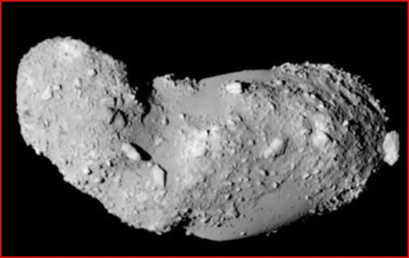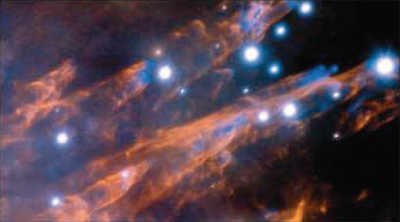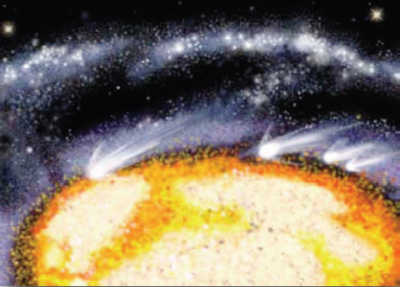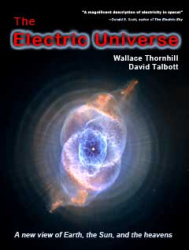|
|
Excerpts From The Electric Universe
Part 8
The following is one of a series of excerpts from The Electric Universe,
copyright © 2002, 2007 Wallace Thornhill and David Talbott and published by
Mikamar Publishing. Reproduced with the kind permission of the authors and publisher.
Presented by Dave Smith
|
|
|
|
May 29, 2010
|
|
|
In this series we have contrasted the dirty snowball model of
comets to the plasma discharge model, questioned how gravity alone
could retain huge comas, explored surface features not expected
of a slushball, discovered that electrical stresses are the most likely
cause of cometary fragmentation, and observed the impacts of comet Shoemaker-Levy 9 with
Jupiter and the Deep Impact probe into comet Tempel 1. Together this outstanding
body of observations must bring into question the orthodox model of comets as it
serves to demonstrate the predictive power of Electric Universe theory.
Page 116:
|
|
|

Image of the asteroid Itokawa
(25143), taken by Japan’s probe
Hayabusa. Asteroid Itokawa
demonstrates the difference
between the surface of a rocky body
that has not suffered electric arc
machining or 'electrostatic cleaning'
like comet Tempel1.
Credit: JAXA
[Click to enlarge]
|
|
|
Comet Origins
Plasma discharge phenomena are scalable over more than 14
orders of magnitude.135
This means that phenomena seen in
the laboratory and recorded in billionths of a second may
span light-years in deep space and could last for centuries or
more. This scalability of plasma phenomena enables us to
compare the detailed structures of high-energy laboratory
discharges with galaxy-sized events in space.
In the Electric Universe model, the solar system has a
dynamic history, unimagined in any prior cosmogony. In our
first volume, Thunderbolts of the Gods, we provide abundant
forensic evidence that the present order in the solar system
was established shortly before the rise of civilization. We observed that
archaic references to comets describe them as being born in the close
approach of planets when “the space between the two planets lights up
and is set aflame by both planets and produces a train of
fire.”136
The description makes clear that this was no modern 'conjunction' of
remote planets where their bright points of light merely appear close
together in the sky.
Instead of conjecture, we have compelling forensic evidence of
the origin of the comets, asteroids and meteoric rocks. They were all
Page 117:
born in the violence of planetary electrical encounters. From this
conclusion, we begin to understand why Mars, the god of war, is the
source of meteorites that still arrive on Earth. Astronomer Tom Van
Flandern has advanced cogent arguments “that comets originated in
the energetic breakup of a body orbiting the Sun in or near the present
location of the asteroid belt in the relatively recent
past.”137 However
his view that a 'nova' type explosion of a former planet was
responsible begs the question of what would cause such an outburst. In
the Electric Universe, a nova is a stellar manifestation of electric
discharge. Consequently, the orbits of comets favor an origin in an
electrical 'planetary nova' event.
A New Perspective
“There is no such thing as consensus science. If it's consensus, it
isn't science. If it's science, it isn't consensus.
Period.”138
From the evidence briefly noted here, we conclude that the
consensus about comets can no longer be maintained. Though the
story has been presented as fact for several decades, a new perspective
is emerging. A comet is an electrical phenomenon, as intuited by 19th
century scientists. The immense envelope of the coma, perhaps several
million kilometers across and bigger than the Sun, is a plasma sheath
enclosing an electrified body. The filamentary comet ion tails,
stretching across the sky, are part of the circuit carrying current from
the comet. Given the fundamental electrical nature of the Sun and
interplanetary space, a comet is subject to electrical transactions far
more energetic and complex than expected.
To state the point bluntly, the underpinnings
of modern comet theory have collapsed, though
no official announcement of this fact has been
forthcoming. Nor has official science yet faced the
implications for planetary history. If cometary
displays are electrical discharges, then a planet on
an elliptical orbit will suffer proportionate
electrical stress. It will become a comet and suffer
surface etching. Certain objects seen in deep space
take on new interest as well, because it is possible
to see them as scaled up analogues of a comet.
|
|
|

The image shows the Orion "bullets"
as blue features and represents the
light emitted by hot iron gas. The
light from the wakes, shown in
orange, is from excited hydrogen
gas. The typical size of one of the
bullet tips is about 10 times the size
of Pluto's orbit around the sun. The
wakes shown in the image are about
a fifth of a light-year long.
Credit: Gemini Observatory
[Click to enlarge]
|
|
|
Indeed, it appears that the Gemini Observatory
using adaptive optics has seen stellar scale 'comets' far from our solar
system in the Orion nebula [above]. And the comet-like formations seen
Page 118:
in the famous Cartwheel galaxy [below], which may be cometary
electrical activity on a galactic scale.
|
|
|

Illustration of comet-like objects
racing at more than 1 million km/hr
through the Cartwheel Galaxy's
center. The 'heads' are a few
hundred light-years across; the tails
are several thousand light-years
long. The string of bright lights in
the background is the galaxy's outer
ring of young stars. The galaxy is in
the constellation Sculptor.
Credit: J. Gitlin (Space Telescope
Science Institute),
and NASA
[Click to enlarge]
|
|
|
Looking Past the Familiar Boundaries
If there is a single message in the evidence we have
summarized here, it is that specialists must pause to hear
witnesses from outside their own disciplines. It is not
customary for the experts on comets to consider the physics of
the Sun. Nor do planetary geologists normally show interest in
the study of lightning. Cosmologists give little attention to the
behavior of auroras.
As theoretical challenges arise, the tendency is to look for solutions
within one's accustomed frame of reference. But will this habit
really serve our interests when the problem lies with our fundamental
assumptions? In the nineteenth and early twentieth centuries, certain
notions came to be codified within the theoretical sciences, as if the
principles were self-evident and could not be questioned—the rule of
gravity, the stable and predictable solar system, and the electrically
neutral cosmos. Yet many of the challenges to these suppositions come
from outside any particular specialty. If a foundational assumption is
challenged by unexpected patterns of discovery, a predicament will
arise. Within the different fields, the specialists will not realize that the
most important clues could lie outside their familiar subject.
If lightning and auroras involve electric interactions of the Earth
and the Sun, then space plasma is not electrically inert and
cosmologists' faith in gravitational models is misplaced. If the Io
plumes are electrical discharges, then planetary geology must be
rewritten. If a comet is discharging electrically as it approaches the
Sun, then the Sun is the center of a radial electric field, though solar
physicists have never entertained the possibility.
Similarly, if distinctive surface features of solid planets, moons,
and lesser rocks in the solar system were created electrically, then
long-standing assumptions about planetary stability are mistaken, and
the implications will reach far beyond planetary geology. All inquiry
into the Earth's history will be affected.
|
|
|
References:
135 A. L. Peratt,
Physics of the Plasma Universe, (Springer-Verlag) 1992, p. 48.
136 Seneca, Naturales
Quaestiones, 7. 12. 1, transl. Corcoran II 1972: 250-51.
137 T. Van Flandern,
Dark Matter, Missing Planets & New Comets, pp. 185-6.
“[Asteroid] orbits exhibit 'explosion signatures,'
which are a set of characteristics in
the distribution of orbits that imply origin in an explosion.”
138 M. Crichton,
"Aliens Cause Global Warming," a lecture at CalTech, Pasadena, CA,
January 17, 2003.
|
|
|
|
|
Permalink to this article.
Email this article to a friend
Public comment may be made on this article on the
Thunderbolts Forum/Thunderblogs (free membership required).
To read more from Wal Thornhill please visit:
holoscience.com
|
|
|
|
|
|
|
|
|
YouTube video, first glimpses of Episode Two in the "Symbols of an Alien Sky"
series.
|
|
|
|
|
|
|
Three ebooks in the Universe Electric series are
now available. Consistently
praised for easily understandable text and exquisite graphics.
|
|
|
|
|
|
|
|










